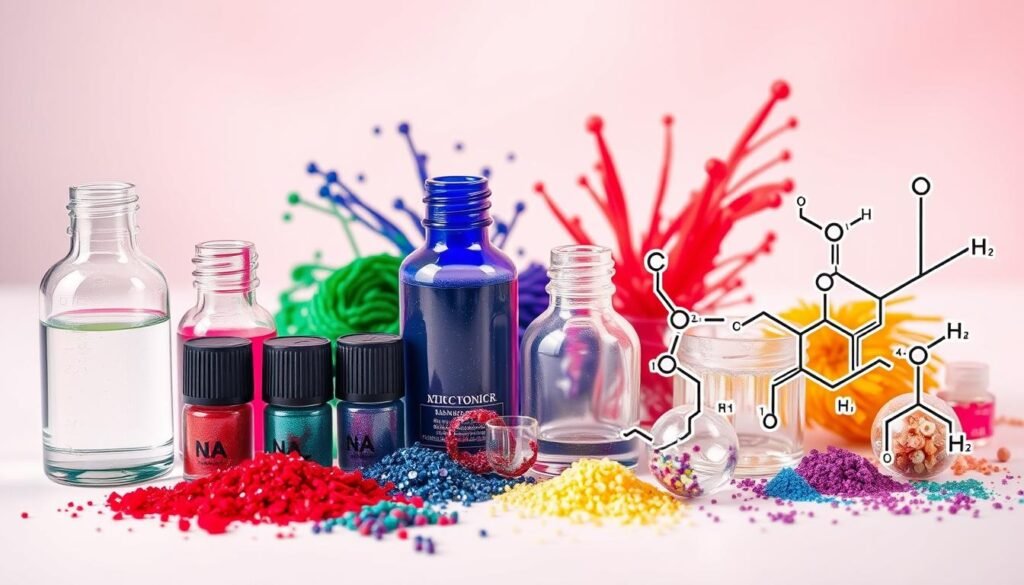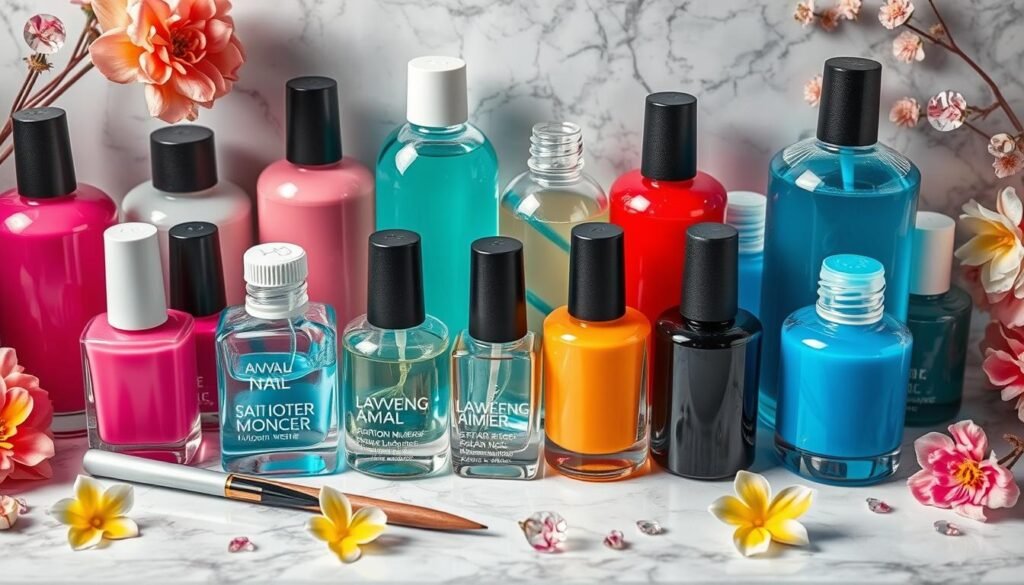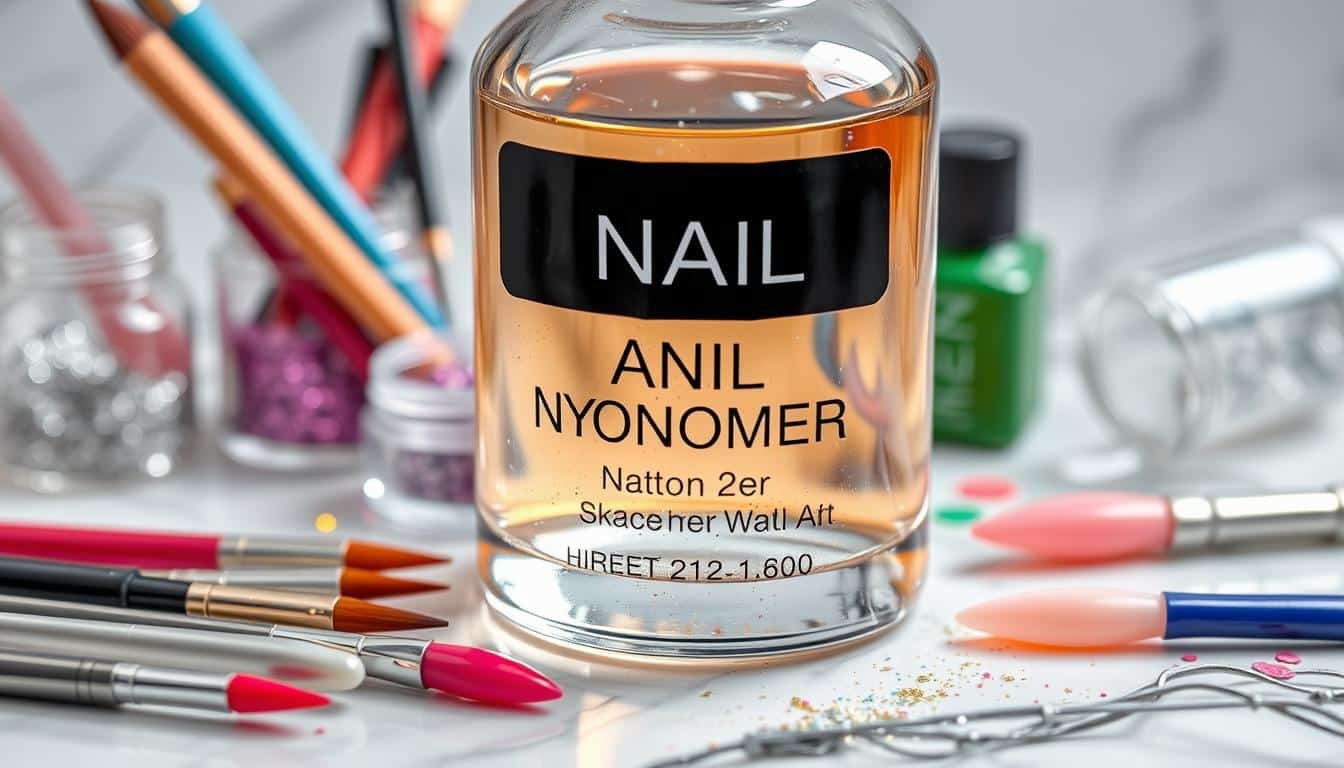Ever wondered about the secret behind those flawless acrylic nails? The answer lies in a crucial component called monomer. But what is monomer for nails, and why is it so important in nail care?
Monomer is the liquid magic that turns powdery polymers into sculpt-able acrylic nails. It’s a key player in the world of nail artistry. It allows technicians to create durable, long-lasting extensions. This essential liquid typically contains ethyl methacrylate (EMA) as its main ingredient, along with other additives that enhance its performance.
When you’re getting acrylic nails, your nail tech combines this liquid monomer with a polymer powder. The result? A pliable substance that can be shaped and molded to create stunning nail designs. But there’s more to monomer than meets the eye. Its composition and quality can significantly impact the final look and longevity of your acrylic nails.
Understanding nail monomer ingredients is crucial for both nail technicians and clients. Quality monomers often have a subtle purple tint, which isn’t just for aesthetics. This tint contains UV inhibitors that prevent yellowing, ensuring your nails stay looking fresh and vibrant for longer.
Whether you’re a nail enthusiast or a professional technician, knowing about liquid monomer for acrylic nails can help you achieve better results. From slow-setting options for beginners to quick-drying competition monomers for pros, there’s a type for every skill level and preference.
Key Takeaways
- Monomer is the liquid component in acrylic nail systems
- It primarily contains ethyl methacrylate (EMA)
- Monomer reacts with polymer powder to create sculpt-able acrylic
- Quality monomers often have a purple tint with UV inhibitors
- Different types of monomers cater to various skill levels and needs
- Using matching monomer and polymer brands is recommended for best results
Understanding Nail Monomers: The Basics
Nail monomers are key in nail care. They help make nails look great and last longer. Let’s learn about nail monomers and why they matter in nail art.
Definition of Monomer in Chemistry
In chemistry, a monomer is a simple molecule that can join with others. For nails, ethyl methacrylate (EMA) is the main monomer. It makes nails strong and light.
Types of Monomers Used in Nail Care
There are many types of nail monomers for different needs:
- Slow-setting monomers for beginners
- Normal-setting monomers for everyday use
- Competition monomers for professional nail artists
- Odorless monomers for sensitive clients
The Role of Monomers in Acrylic Nail Systems
Monomers are vital in acrylic nail systems. They mix with polymer powder to form a moldable substance. This mixture hardens into strong artificial nails. The right mix of monomer and polymer is important for strength and flexibility.
Monomer for gel nails works differently. It’s part of a one-component system that cures under UV light. This gives a glossy, long-lasting finish without mixing.
“Understanding the science behind nail monomers helps nail artists create stunning, durable nail enhancements for their clients.”
The Chemistry Behind Nail Monomers

Nail monomers are key to making manicures look great and last long. Knowing how they work is important for safe and effective nail care.
EMA vs. MMA: Understanding the Difference
Ethyl methacrylate (EMA) and methyl methacrylate (MMA) are two types of nail monomers. EMA is safer for nails. MMA, however, can harm nail health.
| Characteristic | EMA | MMA |
|---|---|---|
| Safety | Safer for nail use | Potentially harmful |
| FDA Status | Approved for nail products | Removed from market in 1970s |
| Potential Risks | Minimal when used properly | Nail plate loss, fingertip sensation loss |
Polymerization Process in Nail Care
The polymerization process mixes liquid monomer with polymer powder. This creates a moldable bead for shaping on the nail. Warmer temperatures speed up drying.
Safety Considerations for Nail Monomers
It’s crucial to follow safety steps with nail monomers. Use products in areas with good air flow to avoid inhaling fumes. Keep skin away from monomers to avoid allergic reactions. Never use MMA for acrylic nails because it’s dangerous.
“The longer the monomer takes to dry, the more time there is to shape the nails.”
By learning about the chemistry and following safety tips, you can have beautiful nails while keeping your health safe.
What Is Monomer for Nails?
Monomer for nails is a key part of acrylic nail systems. It’s a liquid that, when mixed with polymer powder, turns into a moldable material. This material hardens into artificial nails. The main ingredient is usually ethyl methacrylate (EMA), which is safer than methyl methacrylate (MMA).
The liquid monomer is vital for nail enhancements. It helps nail technicians shape and sculpt beautiful, lasting nail extensions. When getting acrylic nails, the technician mixes the monomer with powder to make a dough-like substance. This dough is then applied to your natural nails or nail forms to create extensions.
Choosing high-quality nail monomers is important. They ensure better adhesion, durability, and appearance of your acrylic nails. They also reduce the risk of skin irritation or allergic reactions. Top brands often create their monomers to work best with their powders.
| Aspect | Details |
|---|---|
| Main Component | Ethyl Methacrylate (EMA) |
| Function | Forms moldable substance with polymer powder |
| Application | Used in acrylic nail systems |
| Average Lifespan | 6-8 weeks with proper care |
| Safety Consideration | FDA approved (unlike MMA) |
Understanding what monomer for nails is can help you make better choices for your nail care. Whether you love nails or are a professional, knowing about monomer in acrylic nail systems is key for stunning, lasting results.
Types of Nail Monomers and Their Uses

Knowing about nail monomer types is key for a great manicure. Let’s look at the different monomers for gel nails and their uses in nail care.
Slow Setting Monomers
Slow setting monomers are perfect for beginners. They take more than three minutes to harden. This gives you time to shape and perfect your nail design without rushing.
If you’re new to nail art, this monomer is great. It lets you practice and improve your skills.
Normal Setting Monomers
These monomers harden in two to three minutes. They’re a good choice for most nail technicians. They’re versatile and work well for many nail designs.
Competition Monomers
Competition monomers set in under a minute. They’re made for nail art contests where speed matters. Their quick-drying nature lets you do intricate designs fast.
But, they need a lot of skill and precision to use right.
Odorless Monomers
Odorless monomers are great for those who don’t like strong smells. They solve the problem of strong chemical smells from traditional monomers. They make the experience better for both nail techs and clients.
| Monomer Type | Setting Time | Best For |
|---|---|---|
| Slow Setting | Over 3 minutes | Beginners, detailed work |
| Normal Setting | 2-3 minutes | General use, most nail designs |
| Competition | Less than 1 minute | Nail art contests, speed work |
| Odorless | Varies | Sensitive clients, enclosed spaces |
Choosing the right monomer for gel nails depends on your skill, work environment, and client needs. Each type has its own benefits. They help you create amazing nail art for different situations.
Application Techniques and Best Practices
Learning how to apply monomers is key for beautiful acrylic nails. First, prep your nails and apply a dehydrating primer. Then, mix the monomer liquid with polymer powder on your brush to create a bead.
Apply the bead to the nail, starting at the cuticle and moving to the tip. This helps you get a smooth, even layer.
For newbies, pick a monomer that dries slower. This makes it easier to shape and reduces mistakes. Also, keep your workspace cool to slow down the drying process. Avoid applying too much, as it can harm your natural nails.
The curing process usually takes 10-15 minutes. You can speed it up with UV light or a heated lamp. Keep in mind, colder temperatures slow down drying, while warmer ones speed it up.
- Use the right mix ratio between monomer and polymer for strong, flexible enhancements
- Too much monomer leads to shrinkage and lifting
- Too little results in a weak nail structure
- Practice bead pickup technique for proper acrylic consistency
With the right care, acrylic nails can last 2-3 weeks before needing a fill-in. They’re strong and less likely to chip or break than gel nails. Regular maintenance, like filling in regrowth, helps them last longer.
Remember, safety comes first. Ensure proper ventilation, wear protective clothing, and use a mask to prevent health hazards during the monomer application process.
Conclusion: The Importance of Quality Monomers in Nail Care
Quality monomers are essential for beautiful acrylic nails. Choosing the right monomer means investing in beauty and safety. EMA-based products are the best choice for both professionals and hobbyists.
It’s important to remember that monomer compatibility with your polymer powder is crucial. This ensures the best results for your nails.
Proper storage and handling can extend the life of your monomer. This means you get more use out of your product. Advanced monomers come with a built-in primer, saving you time and reducing lifting issues.
This not only saves money but also makes your nail care routine easier.
Low-odor EMA monomers have made the salon experience better. They are more pleasant for clients and technicians. Although monomer liquid is more expensive than acetone-based removers, its benefits are unmatched in acrylic nail application.
Understanding the chemistry of nail monomers helps you create beautiful, long-lasting nails. It also prioritizes nail health and safety.
FAQ
What is monomer for nails?
What is the role of monomers in acrylic nail systems?
What are the different types of nail monomers?
What is the difference between EMA and MMA monomers?
What safety considerations should be taken when using nail monomers?
How do you apply acrylic nails using monomer?
What factors should be considered when choosing a nail monomer?
Source Links
- What is Monomer and Polymer for Nails? – https://dansnails.com/blog/monomer-and-polymer/
- Liquid Monomer & Acrylic Nails: A Vital Match | VBP – https://vbeautypure.com/blogs/news/acrylic-nails-right-hand-liquid-monomer?srsltid=AfmBOorn6ygbUf_rwjYvDVnfzcSVyEBWuU2DHM4sIh2ksryRYjv4PayU
- Understanding Acrylic Chemistry & Mix Ratio – https://www.katiebarnesacademy.com/blogs/nail-structure-application/understanding-acrylic-chemistry-mix-ratio?srsltid=AfmBOoo5k5mNxK6rZdD7dFuGDyo90SVJeAXOZ5HsuusSiEgYBs-HCxWB
- Unlocking the Secrets: Understanding the Composition of Nail Supply Products – https://enlnailsupply.com/blogs/news/unlocking-the-secrets-understanding-the-composition-of-nail-supply-products?srsltid=AfmBOooBhyGXAhiw8iETqkYmUjiYd0PJjBeLbtGQSy-2goVjfeh4kSFH
- Liquid Monomer and Polymer Powder (L&P) – NailKnowledge – https://nailknowledge.org/nail-knowledge-base/liquid-monomer-and-polymer-powder-lp
- What Is Monomer For Nails? Guide to Acrylic Nail Liquid – https://www.notpolish.com/blogs/article/what-is-monomer-for-nails?srsltid=AfmBOopQVSiM9Izam18s8Jc5mmm9d5am2CwqoJ3KytC22GNb5PWFk0KT
- Liquid Monomer & Acrylic Nails: A Vital Match | VBP – https://vbeautypure.com/blogs/news/acrylic-nails-right-hand-liquid-monomer?srsltid=AfmBOor8tBq7ZspAxbN4Cl9NvIe-LC70n0Wk4rMm8zfsDeaFFAxzjGS5
- What Is Monomer For Nails? Guide to Acrylic Nail Liquid – https://www.notpolish.com/blogs/article/what-is-monomer-for-nails?srsltid=AfmBOorp5uS5PtL3Rxeo7IOQOX_Of4D0VcoJW4be3HlATIUg6aDSuqlj
- A Quick Guide to Monomer and Polymer for Nails – https://nailcompany.com/blogs/news/a-quick-guide-to-monomer-and-polymer-for-nails
- What is an Acrylic Monomer and How to use it for Nails? – https://medium.com/@wowbaonails05/what-is-an-acrylic-monomer-and-how-to-use-it-for-nails-004647b1c70b
- EMA vs. MMA: Is your full set actually bad for you? – Nest Nail Wellness Spa – https://nestnailwellness.com/blog/ema-vs-mma-is-your-full-set-actually-bad-for-you/
- Understanding Acrylic Chemistry & Mix Ratio – https://www.katiebarnesacademy.com/blogs/nail-structure-application/understanding-acrylic-chemistry-mix-ratio?srsltid=AfmBOooizpjm6t2vDdxiTxsAGD48HiI2CIjgl7afOiH0qp7z050Q96Jx
- Mastering the Art of Acrylic Nails: Your Complete How-To Guide – https://www.aaliyahbeautybar.com/post/acrylic-nails-tips-tricks-and-trends
- Generic Acrylic Nail Application Guidelines – https://www.hooked-on-nails.com/acrylic.html
- Monomer with Built-in Primer: The Key to Professional-Grade Nails – Purple Phoenix Nail Supply – https://purplephoenixnailsupply.com/blogs/news/monomer-with-built-in-primer-the-key-to-professional-grade-nails?srsltid=AfmBOoqjzgiDCPCrjZxWKIKjUE5w6K2Sw2CRs0NWRfD0bCf-HlDqeXxI
- What Can You Use Instead of Monomer for Acrylic Nails? – https://fairyglamor.com/blogs/dip-acrylic-nail-powder-help/what-can-you-use-instead-of-monomer-for-acrylic-nails?srsltid=AfmBOooQFpk1Vd3zEa9mqnP3pLTA4DHYyGQObTUgyzxkXrhceHeoO0os








Interesting read, but arent these nail monomers potentially harmful? Why risk health for beauty? Just my two cents, folks!
Interesting read, but arent natural nail care methods better and safer? Do we really need to use these chemical-laden monomers? Just food for thought.
Honestly, isnt calling it nail care just a fancy way to excuse the chemical damage we willingly do to our nails?
Interesting article, but arent we ignoring the potential health implications of long-term exposure to nail monomers? Lets discuss, folks!
Interesting read, but isnt it high time we consider the health implications of monomers, rather than just the aesthetic benefits? Just a thought.
Interesting read, but isnt overuse of these nail monomers potentially harmful? Why glamorize something that could pose a risk? Just a thought.
Perhaps the same could be said about coffee, alcohol, or even social media use?
Interesting read, but arent we neglecting potential health risks of these nail monomers? Maybe its time to push for more natural alternatives, no?
Natural alternatives arent always safer. Lets focus on proper usage instead of demonizing synthetics.
Anyone else think monomer smells awful? Maybe we should petition for fragrance-infused ones! #MonomerPerfumeRevolution 😂